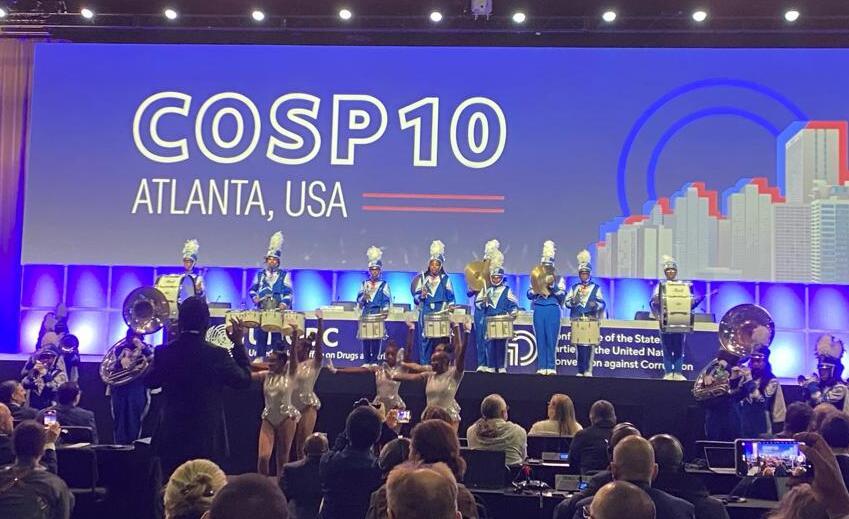Blog
Gender and corruption resolution at UNCAC–COSP: Progress underway, yet paths to inclusion remain

This blog is the second of a two-part series.
Part 1 describes the long road to an UNCAC resolution focused on gender – and why it was critically important to achieve one.
This blog, part 2, explains how the resolution itself, with all its strengths and perceived weaknesses, is a reflection of our times, concluding that it is a ‘good enough’ basis for some very positive next steps.
After gruelling informal negotiations among the States Parties – some of which I participated in (thanks to the Government of Norway for including me in its delegation) – the resolution was was passed by consensus, with Ghana as the main mover and Chile, Ecuador, Morocco, Norway, Switzerland, and the United Kingdom supporting. It was an exciting moment!
What the resolution achieved and what it left out
The resolution is a substantial victory for both the anti-corruption and gender equality movements. Its provisions cover most of the ‘five asks’ that the UNCAC coalition made of States Parties in the run-up to the conference. Here is a brief summary of the asks and my opinion on how they fared in the resolution:
|
A human rights-based and inclusive approach The UNCAC Coalition asked States Parties to recognise that corruption is a vehicle for discrimination and affects persons with disabilities, children and young people, minorities, refugees, migrants, and internally displaced persons, thereby worsening social exclusion and deepening inequality. |
Not achieved
|
|
Combating sexual corruption Despite growing attention, the true extent and nature of the problem is not known. Including it in the resolution would help to focus global attention, improve understanding and accelerate the search for solutions. |
Achieved |
|
Mainstreaming gender equality and inclusion in anti-corruption frameworks Anti-corruption frameworks should embrace inclusive language and consider the impact of corruption on different groups. They should also consider the likelihood of unintended negative consequences of anti-corruption interventions on vulnerable groups. |
Partially achieved (States are urged to mainstream gender equality but inclusion is not mentioned) |
|
Affirmative action Different groups affected by corruption should be actively and meaningfully engaged in participatory mechanisms at every stage of public policy development, including design, implementation, and evaluation. |
Partially achieved (involving women and women’s groups mentioned, but not other marginalised groups) |
|
Gender disaggregated data collection and analysis The coalition urged States Parties to ensure that corruption data avoid a ‘women and men’ approach but should reflect the diversity within subgroups and capture all aspects of their lives, such as age, ethnicity, education, disability, marital status, citizenship status, and sexual orientation, etc. |
Partially achieved (gender disaggregated data mentioned, but focuses on men, women, boys and girls) |
As a long-time gender and corruption practitioner and adviser, for me, the success or failure of the entire resolution hinged on whether a provision on sexual corruption would be included. As explained in the previous blog, the phenomenon encapsulates the gendered nature of corruption and the folly of not applying a gender lens to anti-corruption policies and measures. Excluding sexual corruption would therefore have been a considerable oversight. For over a decade, leading voices in the women’s rights and anti-corruption movements such as the International Association of Women Judges have been calling for sexual corruption, often known as sextortion, to be explicitly addressed in international and national law. The inclusion of provisions on sexual corruption is therefore momentous.
Resolution 10/10 provides that:
Recognizing also that demanding sex or acts of a sexual nature within the context of the abuse of authority may be considered a particular form of corruption, which is primarily perpetrated against women and girls, and concerned about the serious negative impact of such situations on them….
And:
Encourages States parties to raise awareness that demanding sex or acts of a sexual nature within the context of the abuse of authority may be considered a particular form of corruption, and to close potential legislative gaps, as necessary, and take further measures, as needed and appropriate, in order to prevent and prosecute such forms of corruption effectively.
A resolution of our times
The resolution – ‘Addressing the societal impacts of corruption’ – can and should be analysed on its own merits, and the UNCAC Coalition has done so succinctly here. And it is also important to situate it within historical and contemporary debates and practices on gender equality and women’s rights in the world today, including the backlash against gender equality. Taking this view enables us to see that the resolution reflects the global patchwork of progress alongside equivocation on women’s rights.
Moreover, we should bear in mind the limitations of all UNCAC-CoSP resolutions, which are (in the words of the UNCAC Coalition) ‘negotiated until all countries agree on the text and thus reflect the lowest common denominator.’ So the shortcomings of the resolution should be regarded as a reflection of realpolitik and the unfortunate reality that gender equality has not yet been fully accepted as a global norm. This equivocation is further reflected in the resolution’s generic title, which deliberately shies away from directly stating its full purpose, as well as in the resolution’s preoccupation with ‘empowering women and girls’ as opposed to achieving gender equality through an intersectional approach.
A missed opportunity to be more inclusive
The absence of a more inclusive approach that embraces all marginalised groups is indeed disappointing.The analysis by the UNCAC Coalition decries the lack of an intersectional perspective, pointing out that ‘gender is referenced six times in the resolution, while in most cases references are made to women (referenced 19 times) and girls.’ Moreover, ‘Despite the resolution’s title… the resolution does not include a focus on corruption’s impacts on other vulnerable groups such as people with disabilities, minorities, refugees and internally displaced people.’
How do we move on from here? We should recall that there are existing international human rights treaties, declarations, and frameworks for marginalised groups such as persons with disabilities, refugees, internally displaced persons and minorities which have been widely ratified, meaning that there is already international consensus that these groups deserve special protection. We should therefore view their exclusion from the resolution not as an unfortunate occurrence, but as an opportunity to work together to introduce another CoSP resolution that caters specifically to the impact of corruption on these groups and compliments the Joint Statement already published by other UN bodies. In the meantime, we can draw upon this statement and other international guidance that takes a more inclusive and intersectional approach.
A ‘good enough’ foundation for gender mainstreaming in anti-corruption initiatives
Overall, despite its weaknesses, we should celebrate Resolution 10/10 as a ‘good enough’ foundation for mainstreaming gender in anti-corruption initiatives. It gives the United Nations Office on Drugs and Crime (UNODC) a basis from which to expand its work on gender and corruption and contains stipulations that activists, practitioners, and policymakers can invoke in their gender mainstreaming work.
The call to States to mainstream a gender perspective in their anti-corruption policies and programmes – including in providing protection against retaliation for those affected by corruption, or experts, witnesses, and their relations – is particularly welcome. This provision will be widely interpreted to advocate for more gender-sensitive corruption reporting and whistleblowing mechanisms, a crucial component of any anti-corruption strategy. This is important because surveys consistently show that women are less likely to report corruption than men and are more afraid that they will face retaliation if they do so.
Gender and corruption researchers, academics, trainers, and educators have reason to be excited, as States are urged to conduct further research on how corruption undermines gender equality and the principle of equality before the law. States should also enhance the empowerment of women and girls through anti-corruption education and training programmes at all levels of education, including training programmes for public officials and the private sector. A provision encouraging States Parties to promote anti-corruption measures to ensure that women, men, girls, and boys have equitable access to life-saving treatments, affordable medicines and other health-care services will bolster the efforts of those working on health sector corruption such as the Global Network on Anti-Corruption Transparency and Accountability in Health (GNACTA).
Similarly, women’s civil society organisations can be re-energised by the provision encouraging States to promote the meaningful participation and engagement of women’s organisations in anti-corruption policymaking and implementation. The women’s movement as a whole has been beset by the dearth of gender-disaggregated data, so the exhortation to collect gender-disaggregated data on experiences of corruption is much needed.
Sharing knowledge will be crucial in efforts to mainstream gender in anti-corruption, so it is notable that the resolution encourages States Parties to share good practices on empowering women and girls. Furthermore, the UNODC is requested to continue to provide technical assistance to States Parties to support the implementation of the resolution. UNODC is also requested to share information with other UN entities in order to promote the resolution. This will provide an opportunity for collaboration with UN Women and other women’s rights and gender equality policymaking bodies such as the Commission on the Status of Women (part of the UN Economic and Social Council).
Lastly, money will be crucial in ensuring that we move beyond the rhetoric and take the recommended concrete steps to realise the commitments in this historic resolution. States should heed the call to provide extra-budgetary resources to promote the resolution’s implementation. Bilateral donor agencies, multilateral funding bodies, and philanthropic foundations should generously fund efforts to mainstream gender in anti-corruption initiatives, not only because this is a proven approach that works, but also because it is the right thing to do.
Disclaimer
All views in this text are the author(s)’, and may differ from the U4 partner agencies’ policies.
This work is licenced under a Creative Commons Attribution-NonCommercial-NoDerivatives 4.0 International licence (CC BY-NC-ND 4.0)


